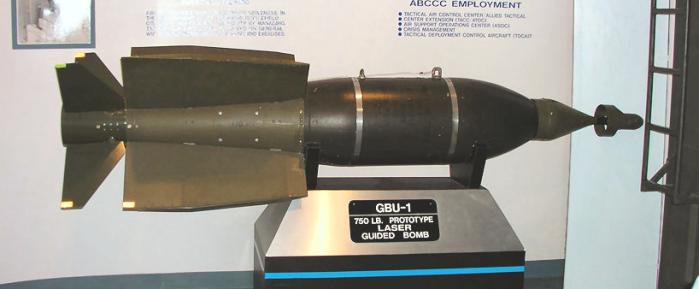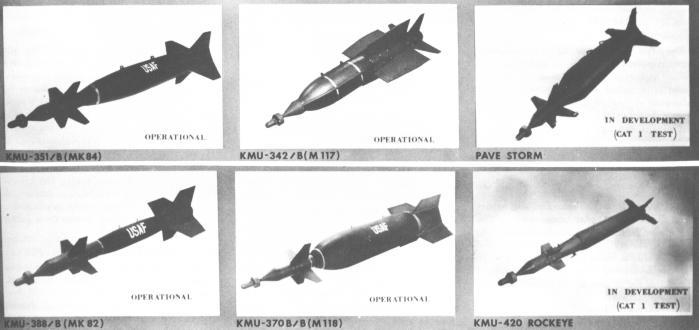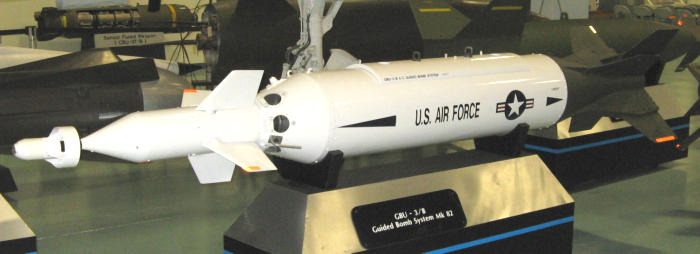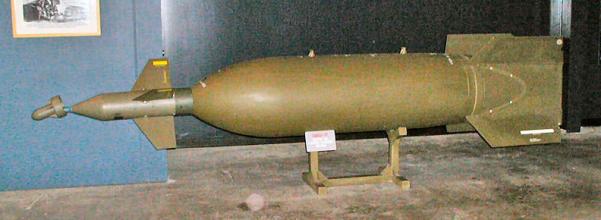Texas Instruments Paveway I & Pave Storm
(GBU-1/B, GBU-2/B, GBU-3/B, GBU-5/B, GBU-6/B, GBU-7/B,
GBU-10/B, GBU-11/B, GBU-12/B)
History and General Description
In 1965, the USAF's Armament Development and Test Center at Eglin AFB began the evaluation of laser guidance systems for free-fall bombs. Such systems generally consist of a laser illuminator, which marks the target with a laser beam (typically with a near-infrared wavelength), and a seeker, which detects the laser's reflection and guides a weapon towards it. In April 1965, the first successful drop of an LGB (Laser-Guided Bomb) using a guidance system from Texas Instruments (TI) occurred. The Air Force subsequently began the Paveway (originally Pave Way) program for full-scale LGB development, and TI received a contract to produce KMU-342/B laser guidance add-on kits for the 750 lb class M117 general purpose bomb. M117s with a KMU-342/B kit were known as "BOLT-117" (BOLT = Bomb, Laser, Terminal Guidance), and were first used operationally over Vietnam in 1968.
 |
| Photo: © Bill Spidle |
| "BOLT-117" LGB (GBU-1/B) |
Laser guidance not only improved the accuracy of the bombs by about 100 times, but the added stand-off range also often allowed the bombers to stay outside air defense range. After the initial success, Paveway laser guidance kits were designed and produced for a variety of bombs, including the widely used 2000 lb MK 84 and 500 lb MK 82 bombs and several types of cluster munitions (see Variants section below for a detailed rundown of all versions). The original Paveway system was renamed Paveway I after the Paveway II follow-on program had been started in 1972.
 |
| Photo: via Jane's |
| Top: GBU-10/B, GBU-1/B, GBU-2/B Bottom: GBU-12/B, GBU-11/B, GBU-5/B |
A Paveway I add-on kit consisted of a gimballed seeker head, a Computer Control Group (CCG), and a set of airfoils. The latter were made up of fixed cruciform tailfins (also referred to as wings) and four movable canards (except for the KMU-342/B, which had the moving surfaces on the tail). The airfoils of the GBU-2/B, GBU-10/B (MXU-600( )/B) and GBU-12/B (MXU-602( )/B) came in two different versions, with "short wings" and "long wings". The latter had wing extensions for slower delivery speed but higher stand-off range (the extensions could optionally be removed before the mission). The LGB's seeker head was fitted with a ring airfoil which kept it aligned with the bomb's flight path. The CCG had a relatively simple "bang-bang" autopilot, i.e. the control surfaces were either deflected fully or not at all, resulting in a sub-optimal flight path (this drawback was not addressed before the introduction of the Paveway III LLLGB (Low-Level LGB) system). The big advantage of the Paveway concept is that virtually no modifications on the delivery aircraft are necessary. The laser designators, e.g. the early AN/AVQ-10 PAVE KNIFE, or the later AN/AVQ-23 PAVE SPIKE and AN/AVQ-26 PAVE TACK, can be carried either by the delivery aircraft itself or by other aircraft in the strike group. There are also portable laser designators for ground troops.
More than ten thousand Paveway I LGBs were used with great success by the U.S. Air Force over South East Asia. The U.S. Navy hesitated longer to adopt LGBs on a large scale, and dropped only a few hundred Paveway I bombs in that conflict. The reason for this reluctance is the fact that when a sortie is cancelled after the aircraft are already in the air, bombs are normally jettisoned over water for safety reasons before returning to the aircraft carrier. Throwing away relatively expensive electronic guidance kits was considered undesirable. The Navy didn't take full advantage of LGB technology until the introduction of the cheaper Paveway II system. In U.S. military service, all Paveway I guidance kits have been retired in favour of the Paveway II, but residual Paveway I kits have been used for training for some time.
Variants
Early Paveway and Pave Storm versions
The first Paveway LGBs were usually referenced by the KMU-xxx/B designations of the guidance kits, and not by GBU numbers. In some cases it is not even clear if GBU designations for the all-up rounds were ever assigned. The name Pave Storm was sometimes used for cluster bombs with Paveway guidance, especially for the GBU-2/B. The following weapons could be fitted with Paveway I guidance kits:
- M117: 750 lb class general purpose bomb
- M118E1: 3000 lb class demolition bomb (see GBU-11/B section below)
- MK 82: 500 lb class LDGP (Low-Drag General Purpose) bomb (see GBU-12/B section below)
- MK 83: 1000 lb class LDGP (Low-Drag General Purpose) bomb
- MK 84: 2000 lb class LDGP (Low-Drag General Purpose) bomb (see GBU-10/B section below)
- MK 20 "Rockeye": 500 lb cluster bomb, consisting of a MK 7 MOD 2 dispenser filled with 247 MK 118 0.9 kg (2 lb) anti-tank bomblets
- CBU-74/B: Cluster bomb, consisting of a SUU-51/B dispenser filled with 48 BLU-87/B 6.1 kg (13.4 lb) anti-personnel fragmentation bomblets
- CBU-75/B: 2000 lb cluster bomb, consisting of a SUU-54A/B dispenser filled with 1800 BLU-63/B 0.45 kg (1 lb) APAM (Anti-Personnel/Anti-Materiel) fragmentation bomblets
- CBU-79/B: Cluster bomb of the "Gator" family, using 2 kg (4.3 lb) BLU-91/B anti-tank and 1.7 kg (3.7 lb) BLU-92/B anti-personnel mines
- CBU-80/B: Cluster bomb (details not available)
 |
| Photo: Greg Goebel |
| GBU-3/B |
The following table lists all known Paveway I and Pave Storm LGBs:
| Designation | Bomb / CBU | Modification Kit |
|---|---|---|
| GBU-1/B 1 | M117 | KMU-342/B |
| GBU-2/B 2,3 | CBU-75/B | KMU-421/B |
| — 4 | MK 83 | KMU-421/B 5 |
| GBU-3/B | CBU-74/B | KMU-422/B |
| GBU-5/B 1 | MK 20 "Rockeye" | KMU-420/B |
| GBU-6/B 2 | CBU-79/B | KMU-351/B |
| GBU-7/B 2 | CBU-80/B | |
| GBU-10( )/B 6 | MK 84 | KMU-351( )/B |
| GBU-11( )/B 6 | M118E1 | KMU-370( )/B |
| GBU-12( )/B 6 | MK 82 | KMU-388( )/B |
Notes:
- The GBU-1/B and GBU-5/B designations for the M117- and "Rockeye"-based Paveway LGBs should be regarded as not 100%
confirmed. There are also conflicting reports, and it appears that there are two plausible "alternatives" for the GBU-1, -4 and -5
slots:
Alternative #1 is much more likely, especially because even the existence of BLU-89 and -90 bombs with EOGB (Electro-Optical Guided Bomb) guidance kits is unconfirmed in the first place.Alt. #1 Alt. #2 GBU-1/B M117 Paveway I "Rockeye" Paveway I GBU-4/B (unknown) BLU-89/B EOGB GBU-5/B "Rockeye" Paveway I BLU-90/B EOGB - The GBU-2/B, -6/B and -7/B laser-guided cluster bombs have been referred to as Pave Storm.
- There was also a "long wing" GBU-2A/B version.
- The MK 83 bomb with a Paveway I guidance kit was used in small numbers by the U.S. Navy, but apparently no GBU designation was assigned.
- It appears unusual that a 1000 lb GP bomb used the same guidance kit as a 2000 lb CBU. Therefore the KMU-421/B designation for the MK 83 Paveway I kit should be regarded as unconfirmed.
- For GBU-10/B, -11/B and -12/B series, see following sections for details.
GBU-10/B
A 2000 lb class MK 84 bomb with a Paveway I or Paveway II guidance kit (CCG + airfoil group) is designated as GBU-10/B. Known designations of GBU-10/B Paveway I variants include:
| Designation | Warhead | Modification Kit | CCG | Airfoil Group |
|---|---|---|---|---|
| GBU-10/B | MK 84 | KMU-351A/B | MAU-157/B | MXU-600/B |
| GBU-10A/B | KMU-351B/B | MAU-157A/B 1 | MXU-600A/B 2 | |
| GBU-10B/B 3 | KMU-351C/B | MAU-157( )/B 4 | MXU-600( )/B 4 | |
| ( GBU-10C/B through GBU-10K/B: see Paveway II ) | ||||
Notes:
- The MAU-157A/B introduced centering springs for the control fins, an improved thermal battery, and a new arming cable and wire guide.
- The MXU-600A/B was the "long wing" version.
- The GBU-10B/B was apparently produced in small numbers only or not at all.
- The exakt designations of the GBU-10B/B's CCG and airfoil group are not available.
GBU-11/B
A 3000 lb class M118E1 bomb with a Paveway I guidance kit (CCG + airfoil group) was designated as GBU-11/B.
 |
| Photo: © Bill Spidle |
| GBU-11/B |
Known designations of GBU-11/B variants include:
| Designation | Warhead | Modification Kit | CCG | Airfoil Group |
|---|---|---|---|---|
| GBU-11/B | M118E1 | KMU-370B/B | MAU-157/B | MXU-601/B |
| GBU-11A/B | KMU-370C/B | MAU-157A/B 1 | MXU-601A/B |
Notes:
- The MAU-157A/B introduced centering springs for the control fins, an improved thermal battery, and a new arming cable and wire guide.
GBU-12/B
A 500 lb class MK 82 bomb with a Paveway I or Paveway II guidance kit (CCG + airfoil group) is designated as GBU-12/B. Known designations of GBU-12/B Paveway I variants include:
| Designation | Warhead | Modification Kit | CCG | Airfoil Group |
|---|---|---|---|---|
| GBU-12/B | MK 84 | KMU-388/B | MAU-157/B | MXU-602/B |
| GBU-12A/B | KMU-388A/B | MAU-157A/B 1 | MXU-602A/B 2 | |
| ( GBU-12B/B through GBU-12E/B: see Paveway II ) | ||||
Notes:
- The MAU-157A/B introduced centering springs for the control fins, an improved thermal battery, and a new arming cable and wire guide.
- The MXU-602A/B was the "long wing" version.
Specifications
Note: Data given by several sources show slight variations. Figures given below may therefore be inaccurate!
Data for GBU-2A/B, GBU-10/B, GBU-11/B, GBU-12A/B:
| GBU-2A/B | GBU-10/B | GBU-11/B | GBU-12A/B | |
|---|---|---|---|---|
| Length | 4.57 m (15 ft) | 4.32 m (14 ft 2 in) | 4.19 m (13 ft 9 in) | 3.20 m (10 ft 6 in) |
| Diameter | 51 cm (20 in) | 46 cm (18 in) | 63.5 cm (25 in) | 27.3 cm (10.75 in) |
| Fin span | 1.37 m (4 ft 6 in) | 1.14 m (3 ft 9 in) | 1.22 m (4 ft) | 0.99 m (3 ft 3 in) |
| Weight | 1000 kg (2200 lb) | 943 kg (2080 lb) | 1391 kg (3066 lb) | 295 kg (650 lb) |
| Warhead | CBU-75/B cluster bomb | MK 84 bomb | M118E1 bomb | MK 82 bomb |
Main Sources
[1] Bill Gunston: "The Illustrated Encyclopedia of Rockets and Missiles", Salamander Books Ltd, 1979
[2] R.T. Pretty, D.H.R. Archer (eds.): "Jane's Wepon Systems 1972-73", Jane's, 1972
[3] ORDATA Online Website
Back to Directory of U.S. Military Rockets and Missiles, Appendix 5
Last Updated: 13 April 2008